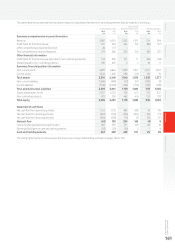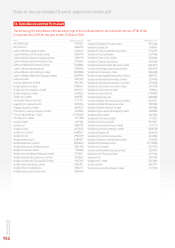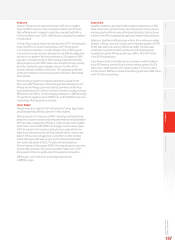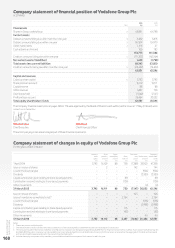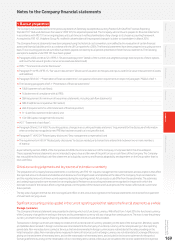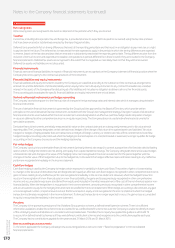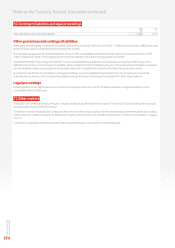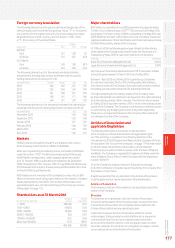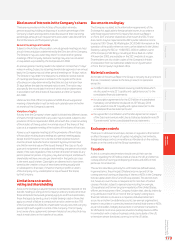Vodafone 2016 Annual Report Download - page 172
Download and view the complete annual report
Please find page 172 of the 2016 Vodafone annual report below. You can navigate through the pages in the report by either clicking on the pages listed below, or by using the keyword search tool below to find specific information within the annual report.
Vodafone Group Plc
Annual Report 2016
170
Notes to the Company nancial statements (continued)
1. Basis of preparation (continued)
Borrowing costs
All borrowing costs are recognised in the income statement in the period in which they are incurred.
Taxation
Current tax, including UK corporation tax and foreign tax, is provided at amounts expected to be paid (or recovered) using the tax rates and laws
thathave been enacted or substantively enacted by the reporting period date.
Deferred tax is provided in full on timing differences that exist at the reporting period date and that result in an obligation to pay more tax, or a right
to pay less tax in the future. The deferred tax is measured at the rate expected to apply in the periods in which the timing differences are expected
to reverse, based on the tax rates and laws that are enacted or substantively enacted at the reporting period date. Timing differences arise from the
inclusion of items of income and expenditure in taxation computations in periods different from those in which they are included in the Company
nancial statements. Deferred tax assets are recognised to the extent that it is regarded as more likely than not that they will be recovered.
Deferredtax assets and liabilities are not discounted.
Financial instruments
Financial assets and nancial liabilities, in respect of nancial instruments, are recognised on the Company statement of nancial position when the
Company becomes a party to the contractual provisions of the instrument.
Financial liabilities and equity instruments
Financial liabilities and equity instruments issued by the Company are classied according to the substance of the contractual arrangements
entered into and the denitions of a nancial liability and an equity instrument. An equity instrument is any contract that evidences a residual
interest in the assets of the Company after deducting all of its liabilities and includes no obligation to deliver cash or other nancial assets.
The accounting policies adopted for specic nancial liabilities and equity instruments are set out below.
Derivative nancial instruments and hedge accounting
The Company’s activities expose it to the nancial risks of changes in foreign exchange rates and interest rates which it manages using derivative
nancial instruments.
The use of derivative nancial instruments is governed by the Group’s policies approved by the Board of Directors, which provide written
principles on the use of derivative nancial instruments consistent with the Group’s risk management strategy. Changes in values of all derivative
nancial instruments are included within the income statement unless designated in an effective cash ow hedge relationship when changes
in value are deferred to other comprehensive income or equity respectively. The Company does not use derivative nancial instruments for
speculative purposes.
Derivative nancial instruments are initially measured at fair value on the contract date and are subsequently remeasured to fair value at each
reporting date. The Company designates certain derivatives as hedges of the change of fair value of recognised assets and liabilities (‘fair value
hedges’) or hedges of highly probable forecast transactions or hedges of foreign currency or interest rate risks of rm commitments (‘cash ow
hedges’). Hedge accounting is discontinued when the hedging instrument expires or is sold, terminated or exercised, no longer qualies for hedge
accounting or the Company chooses to end the hedgingrelationship.
Fair value hedges
The Company’s policy is to use derivative nancial instruments (primarily interest rate swaps) to convert a proportion of its xed rate debt to oating
rates in order to hedge the interest rate risk arising, principally, from capital market borrowings. The Company designates these as fair value hedges
of interest rate risk with changes in fair value of the hedging instrument recognised in the income statement for the period together with the
changes in the fair value of the hedged item due to the hedged risk, to the extent the hedge is effective. Gains and losses relating to any ineffective
portion are recognised immediately in the income statement.
Cash ow hedges
Cash ow hedging is used by the Company to hedge certain exposures to variability in future cash ows. The portion of gains or losses relating
to changes in the fair value of derivatives that are designated and qualify as effective cash ow hedges is recognised in other comprehensive income;
gains or losses relating to any ineffective portion are recognised immediately in the income statement. However, when the hedged transaction
results in the recognition of a non-nancial asset or a non-nancial liability, the gains and losses previously recognised in other comprehensive
income and accumulated in equity are transferred from equity and included in the initial measurement of the cost of the non-nancial asset or non-
nancial liability. When the hedged item is recognised in the income statement, amounts previously recognised in other comprehensive income
and accumulated in equity for the hedging instrument are reclassied to the income statement. When hedge accounting is discontinued, any gain
or loss recognised in other comprehensive income at that time remains in equity and is recognised in the income statement when the hedged
transaction is ultimately recognised in the income statement. If a forecast transaction is no longer expected to occur, the gain or loss accumulated
in equity is recognised immediately in the income statement.
Pensions
The Company is the sponsoring employer of the Vodafone Group pension scheme, a dened benet pension scheme. There is insufcient
information available to enable the scheme to be accounted for as a dened benet scheme because the Company is unable to identify its share
of the underlying assets and liabilities on a consistent and reasonable basis. Therefore, the Company has applied the guidance within IAS 19
to account for dened benet schemes as if they were dened contribution schemes and recognise only the contribution payable each year.
The Company had no contributions payable for the years ended 31 March 2016 and 31 March 2015.
New accounting pronouncements
To the extent applicable the Company will adopt new accounting policies as set out in note 1 “Basis for preparation” in the consolidated
nancial statements.



